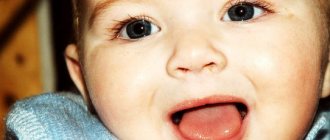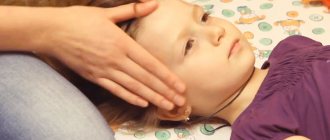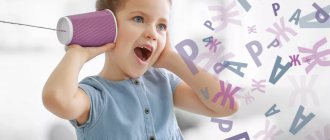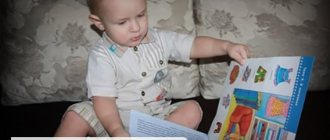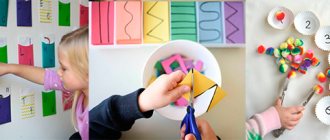Sensory alalia is a disorder in which a child’s speech does not develop due to a lack of understanding of the words of others.
This is a characteristic manifestation of disturbances in the functioning of the speech-hearing analyzer. As a result of a perinatal or postnatal complication, there is underdevelopment of some areas of the brain responsible for the perception and analysis of spoken speech.
With sensory alalia in children, in most cases, complete preservation of hearing is observed. Speech development does not occur due to the lack of connection between the sounds that the child hears and their meaning.
Symptoms of sensory alalia
The sensory alalik is not at all silent. Children have active—sometimes even overly—expressive speech. However, at the same time, they are absolutely not critical of their statements, not understanding themselves what exactly they are saying.
Characteristic features of sensory alalia:
- The mindless repetition of frequently heard phrases is echolalia. The child may persistently repeat advertising slogans, words of cartoon characters, etc. Sometimes speech may seem meaningful if the child repeats the last word he heard along with the answer. But if you change the phrase, there will be no result.
- Frequent confusion of words, syllables and phrases, the use of made-up words - the so-called logorrhea - is another characteristic symptom of sensory alalia.
- In most cases (about 70%), hearing remains intact. However, there is instability of auditory attention. In addition, many alaliks suffer from hyperacusis - increased sensitivity to certain sounds.
- Phonemic speech perception is impaired. That is, the chain through which auditory excitation is transmitted to brain structures associated with speech “does not work” in the child.
- There are also some memory impairments. In order to remember a word or phrase, alalik requires quite a lot of repetition.
So, speech with sensory alalia is absent not because the child has disorders of the auditory or speech or articulatory apparatus, but due to the inability to form a connection between the sound of a word and an object.
Silent child. Alalia
Home — About speech therapy — Silent child. Alalia
Every family eagerly awaits their child's first words. But time passes, and there are almost no words. Or they are there, but they are so illegible and there are so few of them that the family begins to worry. Parents go to specialists and hear: “Your child has alalia.” The term sounds scary and incomprehensible. Let's figure out together what it is.
Each child is unique, so the baby does not always fit into standard developmental norms (when he walked, he began to eat himself with a spoon, he started talking). But, nevertheless, there are a number of alarming factors that should be paid attention to
- this is the so-called “red flag”:
1 year: no babbling, the child does not point to objects and does not communicate with gestures.
1 year and 3 months - does not look at toys, does not show objects and people by name to parents (normally 5-10).
1 year and 5 months - still no first words.
1 year and 6 months - the child does not say “daddy, mommy”, cannot follow simple instructions (smile, raise your hand, etc.).
2 years - does not show body parts, speech contains less than 20 words.
2 years and 5 months - does not answer questions, does not use two-word sentences (Example: mom is walking, let's go for a walk).
3 years old - does not understand prepositions and many verbs, cannot follow two-step instructions (Example: take the typewriter, and now give it to dad), speech has less than 200 words.
If a child has similar disorders, then you should contact a specialist as soon as possible, because Perhaps he has a speech delay of the alalia type.
Alalia
– a speech disorder, which manifests itself in the absence or underdevelopment of speech due to damage to the speech areas of the brain during fetal development or at an early age. In this case, all components of speech are disrupted: sound pronunciation and syllabic structure, phonemic perception, vocabulary and grammar of the native language, coherent speech. This diagnosis can only be made by a doctor (psychiatrist or neurologist) when the child reaches three years of age. Until this time, we are talking about delayed speech development.
Causes
, which can cause alalia are varied. They can act from the moment when the baby is still developing in the mother’s stomach, and until his third birthday.
Alalia is varied in its manifestations: from simple verbal awkwardness to a complete inability to speak and understand spoken speech. There are different approaches; traditionally, they distinguish between sensory (impressive) and motor (expressive) alalia.
Sensory alalia is a disorder of speech understanding that is caused by damage to the temporal lobe of the brain (Wernicke's center). With this type of alalia, the child hears (physical hearing is preserved), but does not understand spoken speech. There are few children with this diagnosis. Identifying and distinguishing sensory alalia from other disorders (for example, early childhood autism, mental retardation, etc.) is difficult.
To better understand how a child with sensory alalia hears speech, imagine that you are in another country, for example, in China. Everyone around you is talking, asking questions, but you don’t understand anything. There is a gap between the meaning/meaning of the word and its “sound shell”, i.e. native speech sounds like a foreign one. All sounds are perceived as a “heap”, speech merges with the surrounding noise.
Children with sensory alalia are characterized by unstable reactions to sounds, i.e. The baby can recognize the speech of his loved ones and not react to the speech of strangers. And if various interferences appear during speech (extraneous noise, the appearance of new people), then these difficulties are aggravated even more. In addition, many children have difficulty distinguishing everyday sounds (Example: what sounds, a hair dryer or a refrigerator?), determining the source and direction of the sound.
Therefore, diagnosis is very important, to separate children with sensory alalia from other children with similar manifestations (autism, hearing loss, etc.) in order to correctly select the types of help and successfully overcome this complex disorder.
Motor alalia
– this is a systemic underdevelopment of speech, in which the child experiences difficulties in constructing an independent speech utterance, while the understanding of addressed speech is relatively intact. This type of alalia is also caused by damage to the parts of the cerebral cortex that are responsible for the motor production of speech. This type of alalia is divided into two forms: afferent and efferent.
Afferent motor alalia is caused by damage to the parietal cortex of the left hemisphere of the brain. This department is responsible for assessing sensations during the speech process: with the help of what movements this or that sound is produced, where we direct the breath at this time, etc. Awareness of this helps to build speech motor complexes, that is, a series of movements to pronounce a certain sound. A child with this form of motor alalia experiences difficulties in constructing these motor programs, since he does not feel the position of the organs of articulation (lips, tongue) and therefore often replaces sounds or does not pronounce them at all. For example, instead of the sound “y” one hears a vague “iy”, instead of “tyu” - “syu”, “gu” - “bu”, etc. That is, sounds are replaced even by ones that are distant in sound and articulation. The syllabic structure is certainly broken: for example, instead of “give” - “da”, “porridge” - “ka”, instead of “car” - “bi”, “ride” is also “bi”, that is, they call different words in one word .. It is difficult for such children to reproduce and remember articulatory patterns even with the help of an adult.
Motor efferent alalia is a consequence of damage to the frontal parts of the cerebral cortex (Broca's center), which combine sounds, words, sentences from individual articulatory movements and “verify” this sequence. Children with this form of motor alalia experience difficulties in transitioning from one sound to another and in reproducing the correct syllable sequence. For example, “sem” instead of “seven”, “khonona” is “good”, “shomasa” is “study”, the speech of such a child is incomprehensible to a stranger. and so on. Difficulties in the transition from one syllable to another are manifested in pauses: “Pa pu is called I go r” and in repetitions of syllables: “found fingers” - found a finger. There are agrammatisms in speech; when asked how old you are, the answer is “five” - five. This form of alalia occurs 9-10 times more often than the afferent one.
To imagine what the speech of a child with motor alalia sounds like, we will give an excerpt from the recording of the boy Vanya (4 years and 11 months), he was telling a turnip fairy tale: “Vyaasa...vyasa. Ani her... tinui-tinui, and couldn’t, and couldn’t make it. Basai ani...ai...zais...mysku...toss." A rough translation sounds like this: “They pulled and pulled, but couldn’t, and didn’t make it. They abandoned her. The hare and the mouse too.” As you can see, for a child who is almost 5 years old, this fairy tale is not so easy to understand or retell.
To summarize, afferent motor alalia manifests itself in difficulties in constructing speech movements, and efferent in difficulties in constructing a sequence of sounds, in combining sounds into words.
In addition to speech manifestations, most children with motor alalia are characterized by motor disorders and an insufficient level of development of fine and gross motor skills. Such children have difficulty fastening buttons and tying shoes; assembling puzzles, appliqués, and modeling also cause difficulties.
Children with alalia get tired quickly, their attention is exhausted, and their perception is fragmented.
Alalia
- this is a speech disorder, the correction of which is carried out not only by a speech therapist, but also by a doctor and a psychologist. A psychiatrist and neurologist will select appropriate drug treatment. The psychologist will deal with the correction and development of mental functions such as perception, attention, thinking. Only an integrated approach will help you “cope” with alalia. This work is lengthy, but it is often possible to achieve verbal communication of the child.
The content of the work is determined individually and depends on the child’s speech capabilities. Sometimes children with alalia do not have basic eye contact, i.e. they simply do not look at the speaker and do not engage in communication. Then the goals and objectives of the work will begin not with the challenge of speech, but with deeper goals - with establishing eye contact, with attracting the child’s attention to the teacher’s speech, with the ability to imitate simple movements upon request, etc. Just as each child is unique, so are the methods of working with alalik. Their speech therapist selects them individually for each child.
Alalia is a complex speech diagnosis. Its correction takes a long time (from several months, in rare cases, to several years) and requires comprehensive assistance: doctors, psychologists, speech therapists. The best age to start working is 3-4 years, when children develop a thirst for knowledge and self-criticism. Based on this, we can talk about the need for early diagnosis, because the earlier alalia is detected, the more time remains for corrective work and the less chance of developing secondary intellectual defects.
Share:
Find out more about the Center's services and sign up for a consultation or lesson
You can call (812)
640-90-77
, or by filling out the form below.
Correction of sensory alalia
Classes to correct this condition are structured depending on its severity. A severe form of alalia, resulting from significant damage to areas of the brain, the child is completely unable to analyze sounds and, accordingly, understand the surrounding speech. A lighter state allows children to be aware of individual words, but not to isolate them in phrasal speech or, conversely, to perceive situationally remembered sentences and not understand words used independently.
To correct sensory alalia, a speech therapist must conduct an examination to correctly determine the severity of the condition and build a lesson plan that includes the necessary exercises and tasks.
Severe forms of this condition can lead to secondary mental and intellectual development disorders, so it is important to find a specialist who will help the child develop his speech.
Forecast and prevention of ANR
For motor alalia, the prognosis for recovery is always favorable. The result of therapy for sensory and sensorimotor diseases is uncertain and depends on many factors: the degree of damage to the speech center of the brain, side pathologies, and the presence of psychosomatic disorders. At school age, children with ODD are faced with written language disorders: dyslexia and dysgraphia.
Prevention of alalia includes:
- monitoring the course of pregnancy;
- long-term breastfeeding;
- early diagnosis of congenital pathologies;
- complex physical development of the child.
This article is posted for educational purposes only and does not constitute scientific material or professional medical advice.
Tasks and exercises for sensory alalia
Speech therapy classes are conducted as part of complex therapy. At the same time, given that the violation is systemic in nature, work is being carried out “on all fronts.” The classes necessarily include exercises for the development of motor skills, attention, memory, and phonemic hearing.
It is important to consider that for children with sensory alalia, uncontrolled sound sources only slow down the correction process, overloading the psyche and not having any speech impact. Therefore, the first thing the specialist recommends is organizing regular “quiet time” in the family and generally limiting the sound environment. Against such a depleted sound background, the child’s sensitivity to speech increases. This state is used during classes.
Causes of alalia
Alalia disease is provoked by various anomalies of pre-speech ontogenesis.
In the antenatal (intrauterine) period, speech pathologies can be caused by:
- hypoxia;
- prematurity;
- torch syndrome;
- perinatal pathology;
- asphyxia of newborns;
- somatic disease of a pregnant woman.
Doctors note a genetic predisposition to the development of alalia. The history of patients with general speech underdevelopment reveals a chain of hereditary factors that provoke dysfunction of the speech areas of the brain.
Etiopathogenetic factors have a significant influence on the physiological development of the speech apparatus:
- rickets;
- meningitis;
- malnutrition;
- encephalitis;
- endocrinopathies;
- traumatic brain injuries;
- lack of competent child development.
In case of intrauterine, congenital or other organic damage to the brain in the first years of a child’s life, the development of nerve cells (neuroblasts) is inhibited. This pathology leads to neuronal inertia and functional depletion of brain cells. In case of alalia, multiple bilateral nature of deviations in the development of speech function, including compensatory capabilities of the brain, are diagnosed.
How to make sure of the diagnosis
Diagnosis of motor alalia in children is possible from 3 years of age. Until this age, its symptoms can be noticed, but in most cases this is only a reason for parents to be wary and an opportunity for the doctor to talk about the likelihood of a diagnosis.
The examination begins with a visit to a neurologist. He makes a preliminary diagnosis. In the differential diagnosis of motor alalia, it is necessary to exclude:
- sensory alalia (speech neurologist);
- hearing impairment (otorhinolaryngologist or audiologist);
- autism, intellectual development disorders (psychiatrist).
Delayed speech development, dysarthria, and aphasia are ruled out by a speech therapist. Based on the data obtained by this specialist and doctors, as well as the results of the examinations they prescribed, the neuropsychologist determines the level and location of brain dysfunction. As a result, the diagnosis of motor alalia is confirmed or refuted.

